door lock Alfa Romeo GT 2006 Owner handbook (in English)
[x] Cancel search | Manufacturer: ALFA ROMEO, Model Year: 2006, Model line: GT, Model: Alfa Romeo GT 2006Pages: 307, PDF Size: 6.05 MB
Page 8 of 307
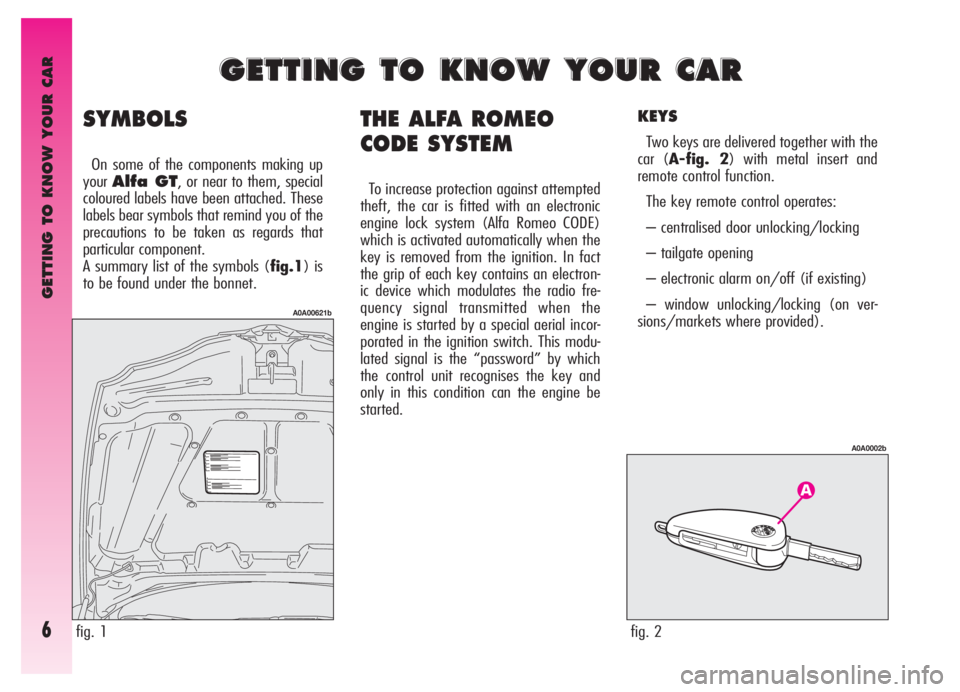
GETTING TO KNOW YOUR CAR
6
THE ALFA ROMEO
CODE SYSTEM
To increase protection against attempted
theft, the car is fitted with an electronic
engine lock system (Alfa Romeo CODE)
which is activated automatically when the
key is removed from the ignition. In fact
the grip of each key contains an electron-
ic device which modulates the radio fre-
quency signal transmitted when the
engine is started by a special aerial incor-
porated in the ignition switch. This modu-
lated signal is the “password” by which
the control unit recognises the key and
only in this condition can the engine be
started.
KEYS
Two keys are delivered together with the
car (A-fig. 2) with metal insert and
remote control function.
The key remote control operates:
– centralised door unlocking/locking
– tailgate opening
– electronic alarm on/off (if existing)
– window unlocking/locking (on ver-
sions/markets where provided).
G G
E E
T T
T T
I I
N N
G G
T T
O O
K K
N N
O O
W W
Y Y
O O
U U
R R
C C
A A
R R
fig. 2
A0A0002b
fig. 1
A0A00621b
SYMBOLS
On some of the components making up
your
Alfa GT, or near to them, special
coloured labels have been attached. These
labels bear symbols that remind you of the
precautions to be taken as regards that
particular component.
A summary list of the symbols (fig.1) is
to be found under the bonnet.
Page 9 of 307

GETTING TO KNOW YOUR CAR
7
The key metal insert operates:
– the ignition switch
-– The driver's door lock and, optional for
versions/markets where applicable, the pas-
senger's door lock
– the passenger’s side air-bag deactiva-
tion
IMPORTANTTo guarantee the perfect
efficiency of the electronic devices con-
tained in keys, avoid letting them directly
exposed to sunrays.
Together with the keys the CODE card is
provided (fig. 3), bearing in print the
key codes (both mechanical and electron-
ic for emergency start up).
The code numbers on the CODE card
must be kept in a safe place , not in the
car.The driver should always keep the elec-
tronic CODE card with him/her in the
event of having to carry out emergency
starting.
U.K. Vehicle only. At the behest of the
motor Insurance Companies the CODE
card for the emergency starting and
replacement of keys are not provided. If
you need assistance please contact your
need assistance please contact your near-
est Fiat Dealership, or telephone Free
Phone 0800717000.KEY WITH REMOTE CONTROL
The key with remote control (fig. 4) is
fitted with:
– a metal insert (A) that can be
enclosed in the key grip
– a button (B) for power-assisted open-
ing of the metal insert
– a button (C) for remote door unlock-
ing and at the same time switching off the
electronic alarm
– a button (D) for remote door locking
and at the same time switching on the
electronic alarm
– a button (E) for remote boot unlock-
ing
– removable hook ring (F).
fig. 3
A0A0003b
If the car changes owner,
the new owner must be
given all the keys and the
CODE card.
fig. 4
A0A0600b
Page 10 of 307
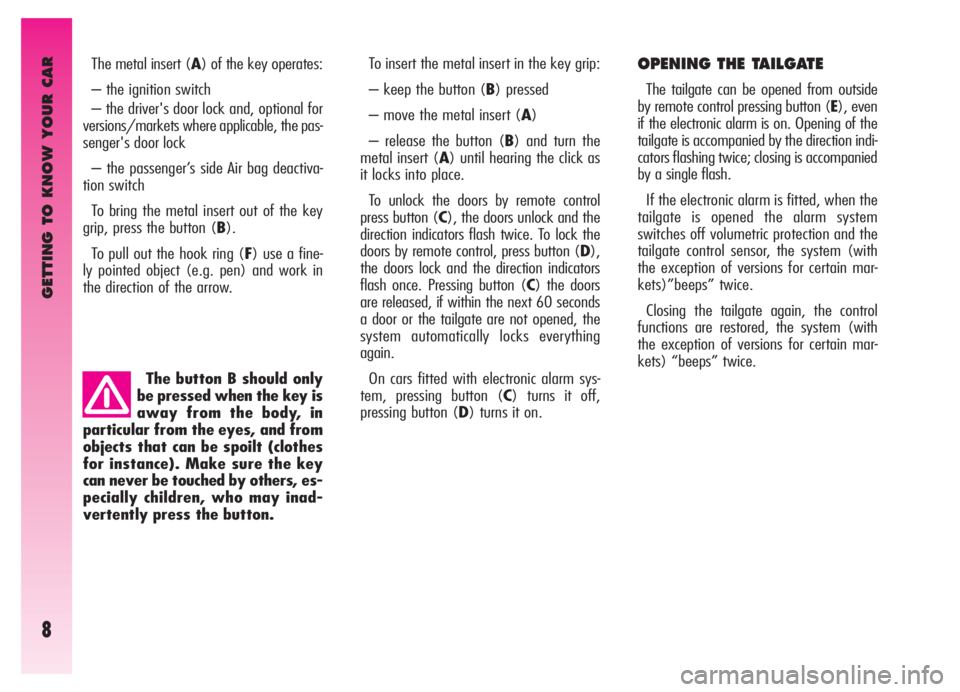
GETTING TO KNOW YOUR CAR
8
The button B should only
be pressed when the key is
away from the body, in
particular from the eyes, and from
objects that can be spoilt (clothes
for instance). Make sure the key
can never be touched by others, es-
pecially children, who may inad-
vertently press the button.
OPENING THE TAILGATE
The tailgate can be opened from outside
by remote control pressing button (E), even
if the electronic alarm is on. Opening of the
tailgate is accompanied by the direction indi-
cators flashing twice; closing is accompanied
by a single flash.
If the electronic alarm is fitted, when the
tailgate is opened the alarm system
switches off volumetric protection and the
tailgate control sensor, the system (with
the exception of versions for certain mar-
kets)”beeps” twice.
Closing the tailgate again, the control
functions are restored, the system (with
the exception of versions for certain mar-
kets) “beeps” twice. The metal insert (A) of the key operates:
– the ignition switch
– the driver's door lock and, optional for
versions/markets where applicable, the pas-
senger's door lock
– the passenger’s side Air bag deactiva-
tion switch
To bring the metal insert out of the key
grip, press the button (B).
To pull out the hook ring (F) use a fine-
ly pointed object (e.g. pen) and work in
the direction of the arrow.
To insert the metal insert in the key grip:
– keep the button (B) pressed
– move the metal insert (A)
– release the button (B) and turn the
metal insert (A) until hearing the click as
it locks into place.
To unlock the doors by remote control
press button (C), the doors unlock and the
direction indicators flash twice. To lock the
doors by remote control, press button (D),
the doors lock and the direction indicators
flash once. Pressing button (C) the doors
are released, if within the next 60 seconds
a door or the tailgate are not opened, the
system automatically locks everything
again.
On cars fitted with electronic alarm sys-
tem, pressing button (C) turns it off,
pressing button (D) turns it on.
Page 13 of 307
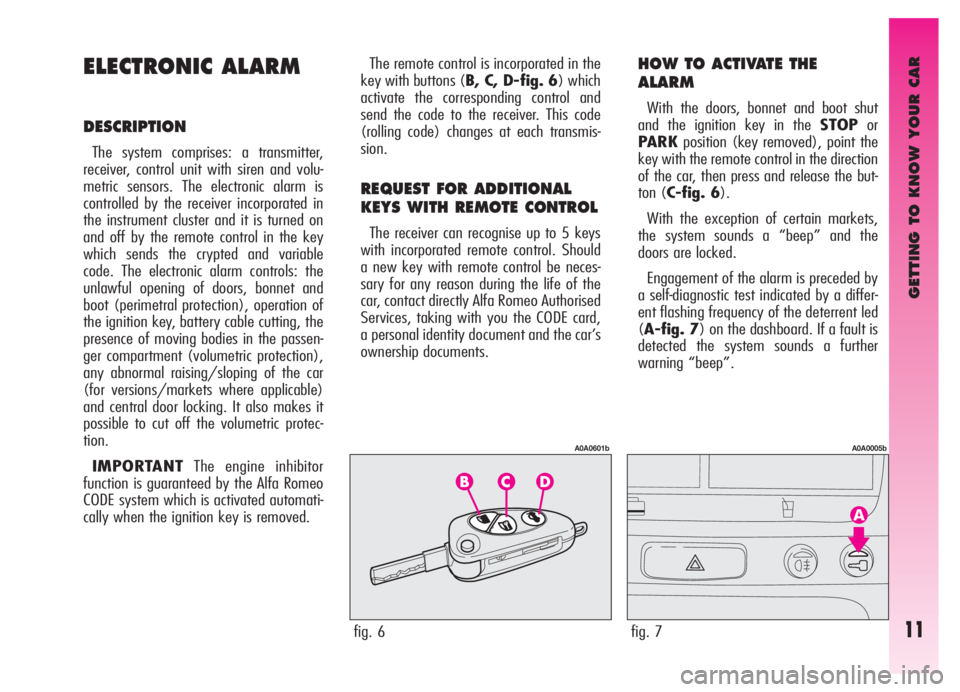
GETTING TO KNOW YOUR CAR
11
ELECTRONIC ALARM
DESCRIPTION
The system comprises: a transmitter,
receiver, control unit with siren and volu-
metric sensors. The electronic alarm is
controlled by the receiver incorporated in
the instrument cluster and it is turned on
and off by the remote control in the key
which sends the crypted and variable
code. The electronic alarm controls: the
unlawful opening of doors, bonnet and
boot (perimetral protection), operation of
the ignition key, battery cable cutting, the
presence of moving bodies in the passen-
ger compartment (volumetric protection),
any abnormal raising/sloping of the car
(for versions/markets where applicable)
and central door locking. It also makes it
possible to cut off the volumetric protec-
tion.
IMPORTANTThe engine inhibitor
function is guaranteed by the Alfa Romeo
CODE system which is activated automati-
cally when the ignition key is removed.The remote control is incorporated in the
key with buttons (B, C, D-fig. 6) which
activate the corresponding control and
send the code to the receiver. This code
(rolling code) changes at each transmis-
sion.
REQUEST FOR ADDITIONAL
KEYS WITH REMOTE CONTROL
The receiver can recognise up to 5 keys
with incorporated remote control. Should
a new key with remote control be neces-
sary for any reason during the life of the
car, contact directly Alfa Romeo Authorised
Services, taking with you the CODE card,
a personal identity document and the car’s
ownership documents.
HOW TO ACTIVATE THE
ALARM
With the doors, bonnet and boot shut
and the ignition key in the STOPor
PARKposition (key removed), point the
key with the remote control in the direction
of the car, then press and release the but-
ton (C-fig. 6).
With the exception of certain markets,
the system sounds a “beep” and the
doors are locked.
Engagement of the alarm is preceded by
a self-diagnostic test indicated by a differ-
ent flashing frequency of the deterrent led
(A-fig. 7) on the dashboard. If a fault is
detected the system sounds a further
warning “beep”.
fig. 6
A0A0601b
fig. 7
A0A0005b
Page 14 of 307
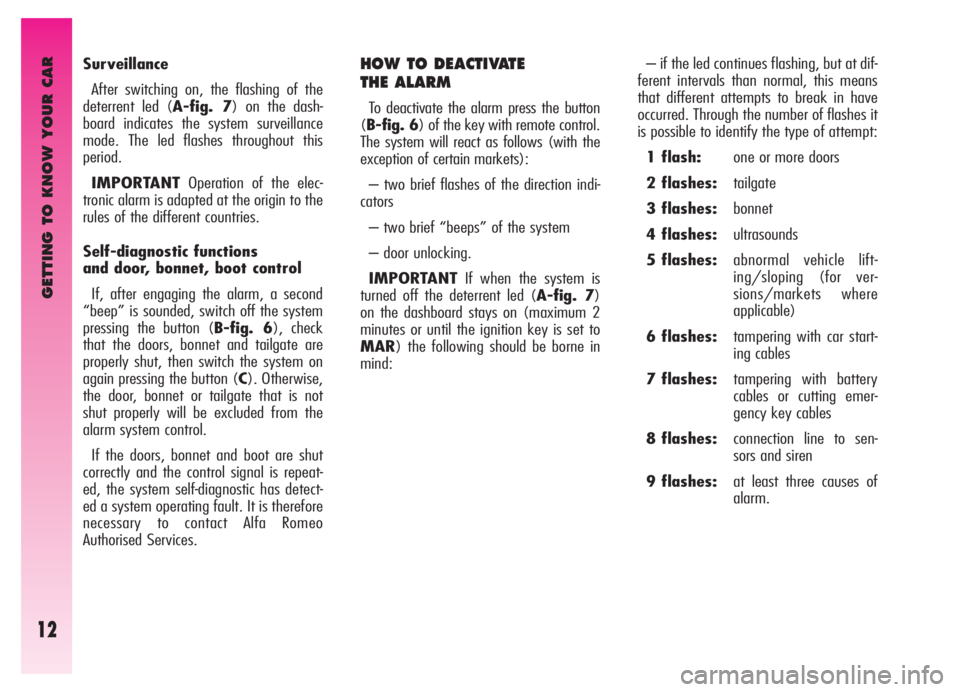
GETTING TO KNOW YOUR CAR
12
– if the led continues flashing, but at dif-
ferent intervals than normal, this means
that different attempts to break in have
occurred. Through the number of flashes it
is possible to identify the type of attempt:
1 flash:one or more doors
2 flashes:tailgate
3 flashes:bonnet
4 flashes:ultrasounds
5 flashes:abnormal vehicle lift-
ing/sloping (for ver-
sions/markets where
applicable)
6 flashes:tampering with car start-
ing cables
7 flashes:tampering with battery
cables or cutting emer-
gency key cables
8 flashes:connection line to sen-
sors and siren
9 flashes:at least three causes of
alarm. Surveillance
After switching on, the flashing of the
deterrent led (A-fig. 7) on the dash-
board indicates the system surveillance
mode. The led flashes throughout this
period.
IMPORTANTOperation of the elec-
tronic alarm is adapted at the origin to the
rules of the different countries.
Self-diagnostic functions
and door, bonnet, boot control
If, after engaging the alarm, a second
“beep” is sounded, switch off the system
pressing the button (B-fig. 6), check
that the doors, bonnet and tailgate are
properly shut, then switch the system on
again pressing the button (C). Otherwise,
the door, bonnet or tailgate that is not
shut properly will be excluded from the
alarm system control.
If the doors, bonnet and boot are shut
correctly and the control signal is repeat-
ed, the system self-diagnostic has detect-
ed a system operating fault. It is therefore
necessary to contact Alfa Romeo
Authorised Services.HOW TO DEACTIVATE
THE ALARM
To deactivate the alarm press the button
(B-fig. 6) of the key with remote control.
The system will react as follows (with the
exception of certain markets):
– two brief flashes of the direction indi-
cators
– two brief “beeps” of the system
– door unlocking.
IMPORTANTIf when the system is
turned off the deterrent led (A-fig. 7)
on the dashboard stays on (maximum 2
minutes or until the ignition key is set to
MAR) the following should be borne in
mind:
Page 15 of 307

GETTING TO KNOW YOUR CAR
13
WHEN THE ALARM
IS TRIGGERED
When the system is on, the alarm comes
into action in the following cases:
– opening of one of the doors, bonnet or
tailgate;
– disconnection of the battery or sec-
tioning of electric cables;
– intrusion in the passenger compart-
ment, for example breakage of windows
(volumetric protection);
– attempt to start the engine (key in
MARposition);
– abnormal car lifting/sloping (for ver-
sions/markets where applicable).
Depending on the markets, the cutting in
of the alarm causes operation of the siren
and hazard warning ligths (for about 26
seconds). The ways of operating and the
number of cycles may vary depending on
the markets.
A maximum number of cycles is howev-
er envisaged.
Once the alarm cycle has ended, the sys-
tem resumes its normal control function.
VOLUMETRIC PROTECTION
To make sure that the protection system
works correctly the side windows and sun-
roof (if fitted) must be properly shut.
The function can be cut off (if, for exam-
ple, leaving animals in the car) carrying
out the following operations in rapid suc-
cession: starting from the condition with
the ignition key at MAR, move the key
toSTOP, then immediately back to
MARand then to STOPagain, then
remove the ignition key.
The deterrent led (A-fig. 7) on the
dashboard lights up for about 2 seconds to
confirm that the function has been cut off.
To restore volumetric protection, move
the and keep the ignition key at MARfor
over 30 seconds.
If, with the volumetric protection func-
tion deactivated, an electric control con-
trolled by the ignition key at MAR(e.g.
power windows) turn the ignition key to
MAR, operate the control and move the
key to STOPin a maximum time of 30
seconds. This way volumetric protection is
not restored.
HOW TO CUT OFF
THE ALARM SYSTEM
To deactivate the alarm system com-
pletely (for instance during prolonged
inactivity of the vehicle) simply lock the
car turning the key in the lock.
MINISTERIAL CERTIFICATION
In accordance with the law in force in
each country, on the subject of radio fre-
quency, we wish to point out that for the
markets in which the transmitter needs to
be marked, the certification number is
given on the component.
Depending on the versions/markets, the
code may also be given on the transmitter
and/or on the receiver.
Page 17 of 307
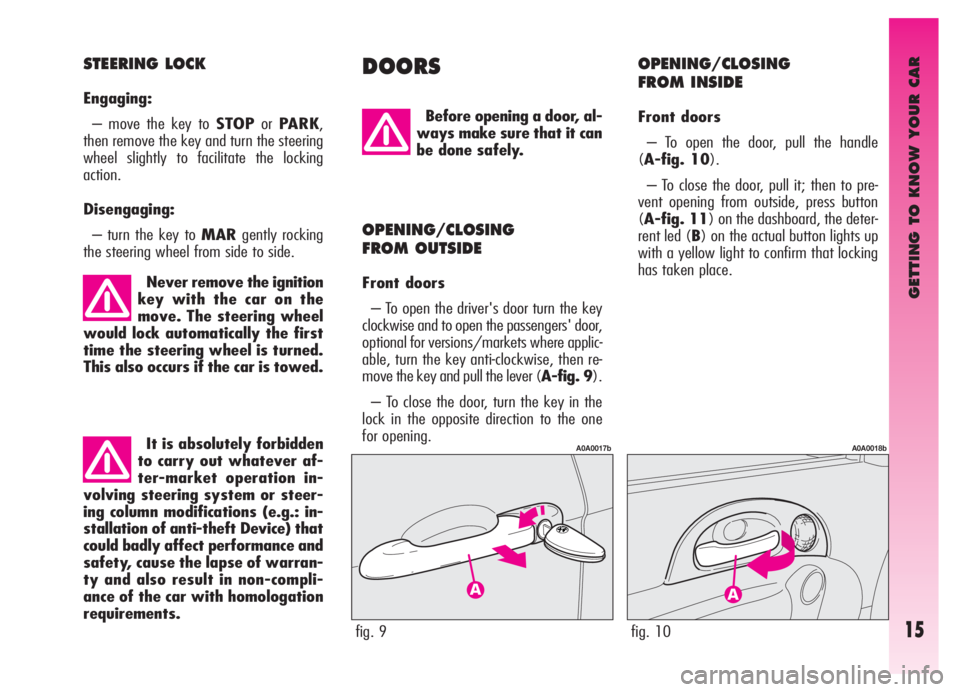
It is absolutely forbidden
to carry out whatever af-
ter-market operation in-
volving steering system or steer-
ing column modifications (e.g.: in-
stallation of anti-theft Device) that
could badly affect performance and
safety, cause the lapse of warran-
ty and also result in non-compli-
ance of the car with homologation
requirements.
GETTING TO KNOW YOUR CAR
15
STEERING LOCK
Engaging:
– move the key to STOPorPARK,
then remove the key and turn the steering
wheel slightly to facilitate the locking
action.
Disengaging:
– turn the key to MARgently rocking
the steering wheel from side to side.
Never remove the ignition
key with the car on the
move. The steering wheel
would lock automatically the first
time the steering wheel is turned.
This also occurs if the car is towed.
DOORS
Before opening a door, al-
ways make sure that it can
be done safely.
OPENING/CLOSING
FROM OUTSIDE
Front doors
– To open the driver's door turn the key
clockwise and to open the passengers' door,
optional for versions/markets where applic-
able, turn the key anti-clockwise, then re-
move the key and pull the lever (A-fig. 9).
– To close the door, turn the key in the
lock in the opposite direction to the one
for opening.
fig. 9
A0A0017b
fig. 10
A0A0018b
OPENING/CLOSING
FROM INSIDE
Front doors
– To open the door, pull the handle
(A-fig. 10).
– To close the door, pull it; then to pre-
vent opening from outside, press button
(A-fig. 11) on the dashboard, the deter-
rent led (B) on the actual button lights up
with a yellow light to confirm that locking
has taken place.
Page 18 of 307
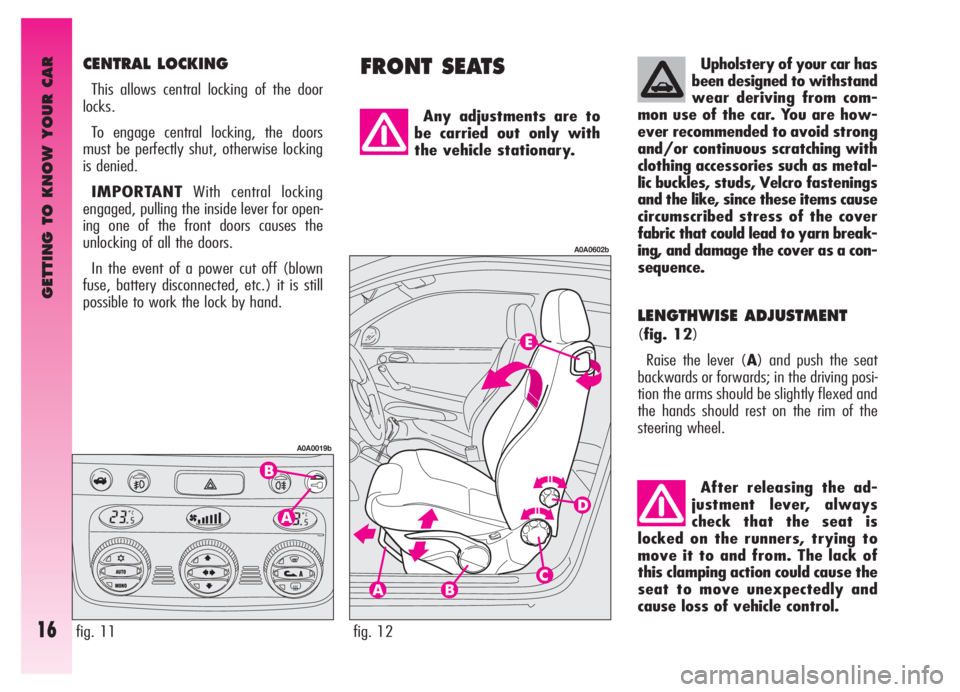
GETTING TO KNOW YOUR CAR
16
FRONT SEATSCENTRAL LOCKING
This allows central locking of the door
locks.
To engage central locking, the doors
must be perfectly shut, otherwise locking
is denied.
IMPORTANTWith central locking
engaged, pulling the inside lever for open-
ing one of the front doors causes the
unlocking of all the doors.
In the event of a power cut off (blown
fuse, battery disconnected, etc.) it is still
possible to work the lock by hand.
fig. 11
A0A0019b
Any adjustments are to
be carried out only with
the vehicle stationary.
LENGTHWISE ADJUSTMENT
(fig. 12)
Raise the lever (A) and push the seat
backwards or forwards; in the driving posi-
tion the arms should be slightly flexed and
the hands should rest on the rim of the
steering wheel.
fig. 12
A0A0602b
After releasing the ad-
justment lever, always
check that the seat is
locked on the runners, trying to
move it to and from. The lack of
this clamping action could cause the
seat to move unexpectedly and
cause loss of vehicle control.
Upholstery of your car has
been designed to withstand
wear deriving from com-
mon use of the car. You are how-
ever recommended to avoid strong
and/or continuous scratching with
clothing accessories such as metal-
lic buckles, studs, Velcro fastenings
and the like, since these items cause
circumscribed stress of the cover
fabric that could lead to yarn break-
ing, and damage the cover as a con-
sequence.
Page 27 of 307

GETTING TO KNOW YOUR CAR
25fig. 33
A0A0043b
fig. 34
A0A0044b
IMPORTANTThe driver’s power win-
dow is fitted with the “continuous auto-
matic operation” device for both lowering
and raising the window. A brief press on
the upper or lower part of the button will
cause it to move and continue automati-
cally: the window stops in the required
position by pressing either the upper or
lower part of the button again.
Passenger’s side (fig. 34)
The button (A) controls the passenger’s
side window.
Button and window operation is the
same as that described for the driver's
side.Do not keep the button
pressed when the window
is completely raised or
lowered.
IMPORTANTFor versions/markets
where applicable, if the car is fitted with the
safety system with crush-prevention seals,
after locking the doors, keeping the remote
control button pressed for about 2 seconds,
causes automatic closing of the windows.
The remote control button should be pressed
until the windows have completed their
stroke; releasing the button sooner, the win-
dows stop in the position they are in at that
moment.
On all versions, after unlocking the doors,
keeping the remote control button pressed
for about 2 seconds, the windows and sun-
roof (if present) are opened.Improper use of power
windows can be danger-
ous. Before and during use,
always make sure that the pas-
sengers are not exposed to the risk
of harm either directly by the mov-
ing windows or by personal objects
drawn or knocked by them.
When leaving the car, al-
ways remove the ignition
key to prevent the power
windows from being operated in-
advertently, and harming anyone
left on board.
Page 28 of 307
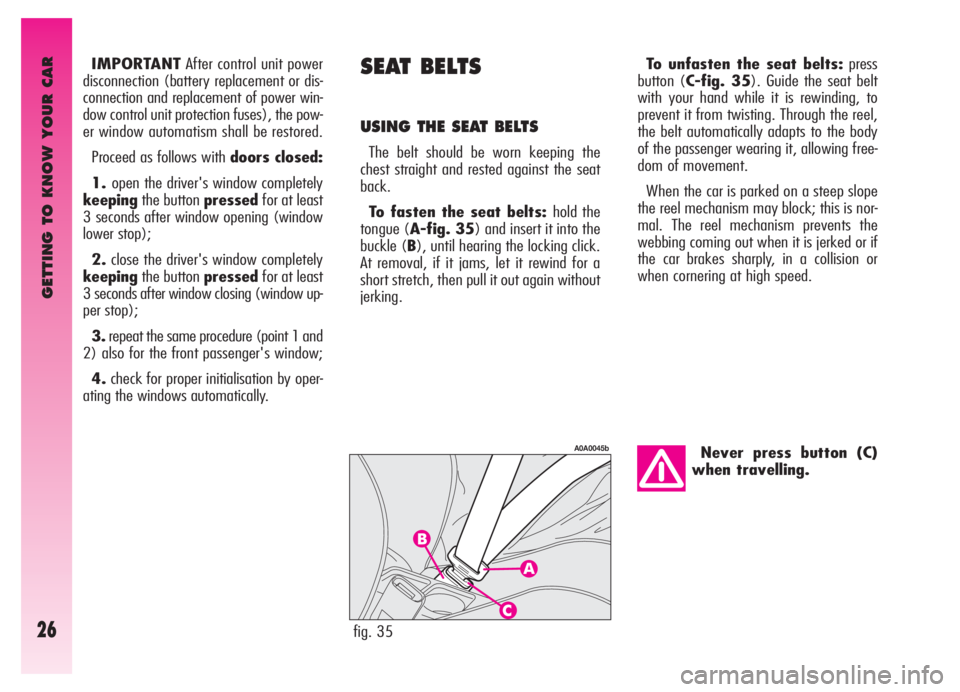
GETTING TO KNOW YOUR CAR
26
Never press button (C)
when travelling.
SEAT BELTS
USING THE SEAT BELTS
The belt should be worn keeping the
chest straight and rested against the seat
back.
To fasten the seat belts: hold the
tongue (A-fig. 35) and insert it into the
buckle (B), until hearing the locking click.
At removal, if it jams, let it rewind for a
short stretch, then pull it out again without
jerking.To unfasten the seat belts:press
button (C-fig. 35). Guide the seat belt
with your hand while it is rewinding, to
prevent it from twisting. Through the reel,
the belt automatically adapts to the body
of the passenger wearing it, allowing free-
dom of movement.
When the car is parked on a steep slope
the reel mechanism may block; this is nor-
mal. The reel mechanism prevents the
webbing coming out when it is jerked or if
the car brakes sharply, in a collision or
when cornering at high speed.
fig. 35
A0A0045b
IMPORTANTAfter control unit power
disconnection (battery replacement or dis-
connection and replacement of power win-
dow control unit protection fuses), the pow-
er window automatism shall be restored.
Proceed as follows with doors closed:
1.open the driver's window completely
keepingthe button pressedfor at least
3 seconds after window opening (window
lower stop);
2.close the driver's window completely
keepingthe button pressedfor at least
3 seconds after window closing (window up-
per stop);
3.repeat the same procedure (point 1 and
2) also for the front passenger's window;
4.check for proper initialisation by oper-
ating the windows automatically.